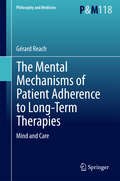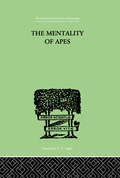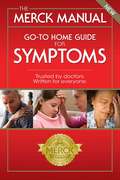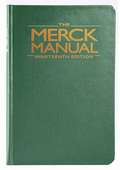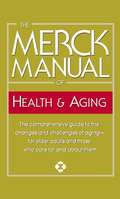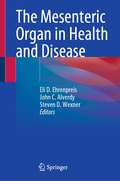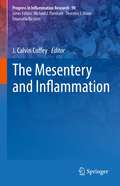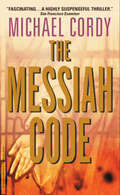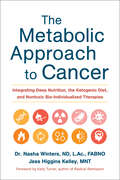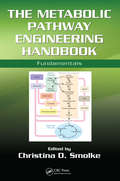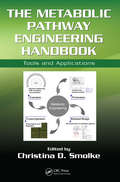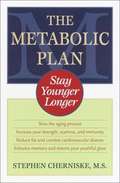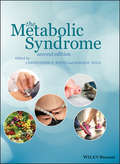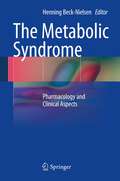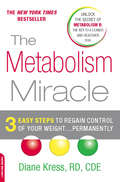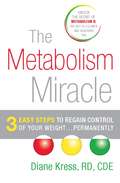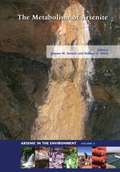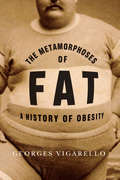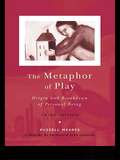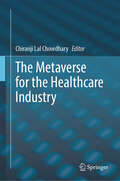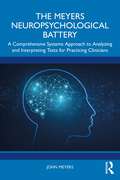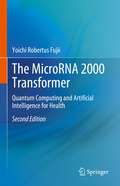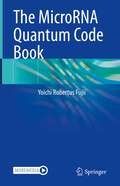- Table View
- List View
The Mental Mechanisms of Patient Adherence to Long-Term Therapies
by Gérard ReachHow can we accept that we ought to stop smoking, follow a diet, exercise, or take medications? The goal of this book is to describe the mechanisms of patients' adherence to long-term therapies, whose improvement, according to the World Health Organization (WHO), would be more beneficial than any biomedical progress. For example, approximately half of the patients do not regularly follow medical prescriptions, resulting in deleterious effects on people's health and a strong impact on health expenditure. This book describes how our beliefs, desires, and emotions intervene in our choices concerning our health, by referring to concepts developed within the framework of the philosophy of mind. In particular, it tries to explain how we can choose between an immediate pleasure and a remote reward--preserving our health and our life. We postulate that such an "intertemporal" choice can be directed by a "principle of foresight" which leads us to give priority to the future. Just like patients' non-adherence to prescribed medications, doctors often don't always do what they should: They are non-adherent to good practice guidelines. We propose that what was recently de-scribed as "clinical inertia" could also represent a case of myopia: From time to time doctors fail to consider the long-term interests of their patient. Both patients' non-adherence and doctors' clinical inertia represent major barriers to the efficiency of care. However, it is also necessary to respect patients' autonomy. The analysis of relationship between mind and care which is provided in this book sheds new light on the nature of the therapeutic alliance between doctor and patient, solving the dilemma between the ethical principles of beneficence and autonomy.
The Mentality of Apes (International Library Of Psychology Ser.)
by Khler, WolfgangFirst Published in 1999. Routledge is an imprint of Taylor & Francis, an informa company.
The Merck Manual Go-To Home Guide for Symptoms
by Robert S. PorterThe Merck Manual Go-To Home Guide for Symptoms takes complex medical information and makes it easy to understand and accessible to an everyday audience. It covers a wide range of everyday symptoms, from abdominal pain to wheezing, and almost everything in between. Every section provides a comprehensive look at each symptom's Causes: both common and less-common, Evaluation: warning signs, when to see a doctor, what the doctor does, and testing, Treatment: a wide-array of options, and Key points: the most important information about the symptom. It also includes helpful tables and illustrations. Organized in a (2- color, 500 page) paperback format makes it easy for busy families to quickly find the information they need. Symptoms covered include: Back Pain, Cough, Fatigue, Fever, Headache, Heartburn, Itching, Joint Pain, Nausea, Swelling and many more....
The Merck Manual of Diagnosis and Therapy
by Robert S. PorterThe world's most widely used medical reference is now better than ever For its 19th Edition, the Merck Manual of Diagnosis and Therapy has been thoroughly updated and thoughtfully expanded, with more than 850 additional pages, 15 new chapters, over 300 new tables, and 56 new figures. Packed with essential information on diagnosing and treating medical disorders, this handy, compact guide was written by a team of clinicians for everyday use by medical professionals for delivery of the best care to their patients. Designed for maximum clinical utility, the new Merck Manual of Diagnosis and Therapy 19th edition makes it easy to find the right information, right when it is needed. It is a must-have for medical students, residents, practicing physicians, nurses, and allied health professionals.
The Merck Manual of Health and Aging
by Mark H. Beers Thomas V JonesThis book intends to help people navigate the health care system and find useful information on health and disease.It also gives in-depth information about most of the disorders that affect older people and about differences in how disorders may affect older people.
The Mercury Solution
by Angela KilmartinThis book contains three sections, all packed with vital prevention and self-help information based on medical facts and simple daily tips, and includes a matching DVD. UTIs are dreadfully common, miserable, frightening, depressing, socially devastating recurrent female illnesses. Both bacterial and nonbacterial causes abound. The author discusses bacterial urinary infections, inflammations, IC, cystitis, hygiene, diet, menopause, children, teens, sex, lifestyle, frequency, pain incontinence, and a lot more.
The Mesenteric Organ in Health and Disease
by Eli D. Ehrenpreis Steven D. Wexner John C. AlverdyRecent discoveries and clarifications of known information about the mesentery have now established that these complex structures function together as an individual organ within the human body. As such, conditions that affect the mesentery can now be grouped within a single area of study and clinical practice. The various aspects of mesenteric diseases have not been brought together in a single source and this book aims to bring them together for the first time. It will cover general areas such as anatomy, histology and physiology of the mesentery. A description of diagnostic procedures used to evaluate patients with mesenteric disorders will follow. A practical survey with detailed descriptions of medical, surgical, and neoplastic disorders of the mesentery is also be included. This book is intended to be a guide for clinical practitioners including gastroenterologists, general surgeons, colorectal surgeons, primary care physicians, nurse practitioners and physician assistants who manage patients with mesenteric disorders.
The Mesentery and Inflammation (Progress in Inflammation Research #90)
by J. Calvin CoffeyThe volume summarizes the most recent advances in our understanding of the mesentery and explains the how these are important in inflammation. It comprises a series of state of the art chapters by leading authorities in each area. It explains how recent advances in our understanding of the mesenteric organ, have advanced the diagnosis and treatment abdominal and systemic conditions including cancer, inflammatory bowel disease and endocrine conditions such as diabetes, and circulatory disorders such as atherosclerosis.
The Messiah Code
by Michael CordyAt the moment of his supreme triumph, a man of science dodges an assassin's bullet and loses everything that truly matters in his life. Now only a miracle can save Dr. Tom Carter's dying daughter: the blood of salvation shed twenty centuries ago.In the volatile heart of the Middle East, amid the devastating secrets of an ancient brotherhood awaiting a new messiah, Tom Carter must search for answers to the mysteries that have challenged humankind since the death and resurrection of the greatest Healer who ever walked the Earth. Because suddenly Carter's life, the life of his little girl, and the fate of the world hang in the balance ...After two thousand years, the wait is over ...
The Metabolic Approach to Cancer: Integrating Deep Nutrition, the Ketogenic Diet, and Nontoxic Bio-Individualized Therapies
by Nasha Winters Jess Higgins Kelley&“Read this important book to learn how cancer is an environmental, metabolic disease with many small causes that stack up—and what you can do to prevent or even reverse it.&”—Dave Asprey, New York Times bestselling author of The Bulletproof DietThe Optimal Terrain Ten Protocol to Reboot Cellular Health!The Metabolic Approach to Cancer offers an innovative, metabolic-focused nutrition protocol that works. Naturopathic, integrative oncologist and cancer survivor Dr. Nasha Winters and nutrition therapist Jess Higgins Kelley have identified the ten key elements of a person&’s &“terrain&” (think of it as a topographical map of our body) that are crucial to preventing and managing cancer. Each of the terrain ten elements—including epigenetics, the microbiome, the immune system, toxin exposures, and blood sugar balance—is illuminated as it relates to the cancer process, then given a heavily researched and tested, non-toxic and metabolic, focused nutrition prescription.The ketogenic diet—which relies on the body&’s production of ketones as fuel—is the centerpiece of The Metabolic Approach to Cancer. Further, Winters and Kelley explain how to harness the anticancer potential of phytonutrients abundant in low-glycemic plant and animal foods to address the 10 hallmarks of cancer—an approach Western medicine does with drug-based therapies.The optimized, genetically-tuned diet shuns:GrainsLegumesSugarGenetically modified foodsPesticidesSynthetic ingredientsThe optimized, genetically-tuned diet emphasizes:Whole, wild foodsLocalOrganicFermentsHeirloomLow-glycemicOther components of their approach include harm-reductive herbal therapies like mistletoe (considered the original immunotherapy and common in European cancer care centers) and cannabinoids (which shrink tumors and increase quality of life, yet are illegal in more than half of the United States). Through addressing the ten root causes of cancer and approaching the disease from a nutrition-focused standpoint, we can slow cancer&’s endemic spread and live optimized lives.&“The Metabolic Approach to Cancer is a powerhouse of detailed information on how to prevent, manage, and treat cancer. . . . It is written in an intimate conversation style that comes from decades of deep personal experience, research, and genuine passion.&”—Travis Christofferson, author of Tripping over the Truth
The Metabolic Pathway Engineering Handbook: Fundamentals
by Christina D. SmolkeThis first volume of the Metabolic Pathway Engineering Handbook provides an overview of metabolic pathway engineering with a look towards the future. It discusses cellular metabolism, including transport processes inside the cell and energy generating reactions, as well as rare metabolic conversions. This volume also explores balances and reaction
The Metabolic Pathway Engineering Handbook: Tools and Applications
by Christina D. SmolkeThis second volume of the Metabolic Pathway Engineering Handbook delves into evolutionary tools and gene expression tools for metabolic pathway engineering. It covers applications of emerging technologies including recent research genome-wide technologies, DNA and phenotypic microarrays, and proteomics tools for experimentally determining flux thro
The Metabolic Plan: Stay Younger Longer
by Stephen CherniskeThe choice is yours: You can add forty or more vigorous, fulfilling years to your life. It sounds like science fiction, but in fact it's cutting-edge science grounded in exciting new research. In The Metabolic Plan,internationally renowned biochemist Stephen Cherniske reveals the medical breakthroughs that enable all of us to extend our lives--and the quality of our lives--starting today. After years of dedicated study and research that took him to six continents, Cherniske has arrived at a new paradigm that radically alters our understanding of the aging process and the human potential for longevity. Far from giving out due to inevitable wear and tear, the human body is naturally endowed with astonishing powers of renewal, self-repair, and regeneration. The secret to unlocking these powers lies not in genetic tinkering or a high-tech fix, but in outsmarting mother nature at her own game. As Cherniske explains, a simple adjustment in your metabolism can profoundly alter your energy level, strength and stamina, your body's ability to fight disease, even the intensity of your sexual desire and fulfillment. In short, by following his regime, you can essentially "trick" your body into adopting the metabolism of a twenty-year-old. The Metabolic Plantakes you step-by-step through the process of natural rejuvenation. Here is a comprehensive diet and exercise plan specifically tailored to boost antioxidant levels, combat disease, increase muscle, reduce fat, and enhance memory and vision. Cherniske shares the age-defying properties of such cutting-edge supplements as 7-Keto and debunks myths about acid/alkaline foods. Here too are detailed metabolic plans geared to the different needs of men and women and to every decade of our lives--so we'll know exactly what to focus on when. Longer life, more energy, improved health, a pervasive sense of well-being: it sounds too good to be true, but it's all within our grasp. At once revolutionary and eminently practical, this is the book that finally solves the puzzle of aging.
The Metabolic Syndrome
by Sarah H. Wild Christopher D. ByrneThe Metabolic Syndrome is a valuable reference text, covering all aspects of the metabolic syndrome and its constituent diseases including inflammation, oxidation and adipocytokines. This book explains the aetiology, pathogenesis and clinical treatment of all risk factors as well as the relationship with diabetes, non alcoholic fatty liver disease, polycystic ovary syndrome and coronary heart disease.The Metabolic Syndrome has been further improved from the 1st edition that was highly commended in 2006 Annual British Medical Association medical books competition. All chapters from the first edition are fully updated and this new edition contains an increase in international contributions and five new chapters on:Childhood obesity and metabolic syndromeBariatric surgery for obesityFitnessBrain insulin resistance and appetiteThe nature of the insulin resistance seen in metabolic syndrome.This brand new edition of The Metabolic Syndrome will be an indispensable resource for all clinical researchers, physicians and scientists requiring detailed up-to-date information on the metabolic syndrome to further their own research or to treat and manage the syndrome and its complications. Specifically, the text will be of particular relevance to those involved and working in the fields of diabetes, endocrinology, obesity, cardiology, vascular disease and hepatology.
The Metabolic Syndrome
by Henning Beck-NielsenThe metabolic syndrome is a common syndrome affecting about 20 % of the adult population in Europe, and probably the prevalence is of the same magnitude in other industrialised countries worldwide. It is mainly caused by western lifestyle resulting in abdominal obesity, but also a genetic predisposition plays a role. This syndrome, which is linked to leisure lifestyle and overeating/obesity, can develop into type 2 diabetes, cardiovascular disease and cancer. Therefore, proper treatment and prevention are heavily needed. This book discusses lifestyle intervention and treatment, specifically with pharmacological compounds, in order to formulate a strategy for treating the metabolic syndrome in the daily clinic.
The Metabolism Miracle
by Diane KressDo you keep gaining weight, despite your efforts to diet? Do the pounds accumulate around your tummy? Do you feel tired, irritable, and unable to focus? If you answered "yes" to any of the above, you may be one of the millions who have Metabolism B, an inherited condition that causes your body to overprocess carbohydrate foods into excess body fat. There is a reason that some people can eat all they want (and seemingly never gain a pound), while the rest of us fret over every carb. Diane Kress, a registered dietitian and weight-loss specialist, has helped thousands with Metabolism B lose weight--and keep it off--with her revolutionary, scientifically based program. Now she shares its secrets here. Among the many life-changing elements of The Metabolism Miracle, you will discover: * The reason why cookie-cutter approaches to dieting (subtracting calories burned from calories consumed) cannot work for those with Metabolism B * The tools to lose weight and reprogram your metabolism permanently * A foolproof method to improve your cholesterol, blood pressure, and blood sugar * The return of your energy, focus, and sense of well-being * Sample menus to help you take it one day at a time * Delicious recipes (including vegan) tailored to match each step * An active lifestyle plan to maintain your newfound body weight. As someone who struggled with Metabolism B for years, Diane Kress knows firsthand the frustration of diets that don't work. Based on the latest research, her own experience, and the experiences of her clients, she has developed this groundbreaking plan to help you take back your life--starting today.
The Metabolism Miracle
by Diane KressDo you keep gaining weight, despite your efforts to diet? Do the pounds accumulate around your tummy? Do you feel tired, irritable, and unable to focus? If you answered yes to any of the above, you may be one of the millions who have Metabolism B, an inherited condition that causes your body to overprocess carbohydrate foods into excess body fat. There is a reason that some people can eat all they want (and seemingly never gain a pound), while the rest of us fret over every carb. Diane Kress, a registered dietitian and weight-loss specialist, has helped thousands with Metabolism B lose weight-and keep it off-with her revolutionary, scientifically based program. Now she shares its secrets here.
The Metabolism of Arsenite (Arsenic in the environment)
by Joanne M. Santini; Seamus A. WardUp to 200 million people in 70 countries are at risk from drinking water contaminated with arsenic, which is a major cause of chronic debilitating illnesses and fatal cancers. Until recently little was known about the mobility of arsenic, and how redox transformations determined its movement into or out of water supplies. Although human activities contribute to the release of arsenic from minerals, it is now clear that bacteria are responsible for most of the redox transformation of arsenic in the environment. Bacterial oxidation of arsenite (to the less mobile arsenate) has been known since 1918, but it was not until 2000 that a bacterium was shown to gain energy from this process. Since then a wide range of arsenite-oxidizing bacteria have been isolated, including aerobes and anaerobes; heterotrophs and autotrophs; thermophiles, mesophiles and psychrophiles. This book reviews recent advances in the study of such bacteria. After a section on background—geology and health issues—the main body of the book concerns the cellular machinery of arsenite oxidation. It concludes by examining possible applications. Topics treated are: The geology and cycling of arsenic Arsenic and disease Arsenite oxidation: physiology, enzymes, genes, and gene regulation. Community genomics and functioning, and the evolution of arsenite oxidation Microbial arsenite oxidation in bioremediation Biosensors for arsenic in drinking water and industrial effluents
The Metamorphoses of Fat: A History of Obesity (European Perspectives: A Series in Social Thought and Cultural Criticism)
by Georges VigarelloGeorges Vigarello maps the evolution of Western ideas about fat and fat people from the Middle Ages to the present, paying particular attention to the role of science, fashion, fitness crazes, and public health campaigns in shaping these views. While hefty bodies were once a sign of power, today those who struggle to lose weight are considered poor in character and weak in mind. Vigarello traces the eventual equation of fatness with infirmity and the way we have come to define ourselves and others in terms of body type. Vigarello begins with the medieval artists and intellectuals who treated heavy bodies as symbols of force and prosperity. He then follows the shift during the Renaissance and early modern period to courtly, medical, and religious codes that increasingly favored moderation and discouraged excess. Scientific advances in the eighteenth century also brought greater knowledge of food and the body's processes, recasting fatness as the "relaxed" antithesis of health. The body-as-mechanism metaphor intensified in the early nineteenth century, with the chemistry revolution and heightened attention to food-as-fuel, which turned the body into a kind of furnace or engine. During this period, social attitudes toward fat became conflicted, with the bourgeois male belly operating as a sign of prestige but also as a symbol of greed and exploitation, while the overweight female was admired only if she was working class. Vigarello concludes with the fitness and body-conscious movements of the twentieth century and the proliferation of personal confessions about obesity, which tied fat more closely to notions of personality, politics, taste, and class.
The Metaphor of Play: Origin and Breakdown of Personal Being
by Russell MearesPersonality disorder can be conceived as the result of a disruption on the development of self. This thoroughly updated edition of The Metaphor of Play examines how those who have suffered such disruption can be treated by understanding their sense of self and the fragility of their sense of existence. Based on the Conversational Model, this book demonstrates that the play of a pre-school child, and a mental activity similar to it in the adult, is necessary to the growth of a healthy self. The three sections of the book - Development, Disruption and Amplification and Integration - introduce such concepts as the exceptional field, paradoxical restoration, reversal, value and fit, and coupling, amplification and representation. This highly readable and lucid presentation of the role of play in the development of self will be of interest not only to therapists but also to those interested in the larger issues of mind and consciousness.
The Metaverse for the Healthcare Industry
by Chiranji Lal ChowdharyThis book delves into the transformative potential of the Metaverse in the healthcare industry, addressing the challenges and opportunities presented by diverse biomedical data and digital healthcare solutions. The book explores how the convergence of technologies like Artificial Intelligence, Augmented Reality, and Virtual Reality can revolutionize healthcare delivery, enhancing patient outcomes and medical education. Chapters cover topics such as the fundamentals of the Metaverse in healthcare, intelligent healthcare systems architecture, ethical considerations, and the integration of IoT devices. Case studies and real-world applications showcase the Metaverse's role in disease prevention, mental health treatment, medical education, and elderly care, offering valuable insights for researchers, practitioners, and professionals in AI, digital health, and healthcare informatics. Designed as a comprehensive reference for academia, research institutions, and healthcare organizations, the book aims to guide the ethical integration of Metaverse technologies into the healthcare ecosystem to unlock their full potential while ensuring patient privacy and security.
The Meyers Neuropsychological Battery: A Comprehensive Systems Approach to Analyzing and Interpreting Tests for Practicing Clinicians
by John MeyersThis book presents detailed information on the Meyers Neuropsychological Battery (MNB) and the statistical system used to interpret the neuropsychological data patterns. By using the statistical methods a more consistent and appropriate interpretation can be made. This book contains information on normative data, performance validity, ecological validity, calculating strengths and weaknesses, comparison groups, and premorbid estimates as well as the statistical methods used with the MNB.The validity and reliability of the MNB as well as the ecological validity are all explained. Another area of detailed explanation is performance validity measures. This includes false positive rates as well as frequency of failures and passing rates for each individual performance validity measure. The statistical methods for group comparisons are demonstrated, which provides the reader with clear examples of how to apply the statistical methods to any test results. Answers are given for many of the questions asked about the MNB and the statistical methods. A modified Rohling's interpretive method is incorporated into the MNB, and demonstrates the benefit this model brings to data interpretation and practical application.This book will be an invaluable tool for clinical neuropsychologists, and all who assess and treat patients with cognitive impairment. The book is also for forensic neuropsychologists who wish to use an objective and consistent interpretive method, and lawyers and judges who wish to understand neuropsychological data and assessment.
The MicroRNA 2000 Transformer: Quantum Computing and Artificial Intelligence for Health
by Yoichi Robertus FujiiThe second edition includes new findings that were only a theory in the first edition, clarifying what is beginning to be proven true. All chapters have been updated, and new data on the analysis of major depressive disorder from exosome microRNA (miRNA) in plasma, traumatic brain injury, and Alzheimer's disease, brain glioma from cerebrospinal fluid miRNA, liver cancer, induced pluripotent stem (iPS) cell tumorigenesis, and other topics have been added. As predicted in the first edition, diseases can be predicted using the miRNA memory package (MMP) and miRNA entangling target sorting (METS), which could clarify the etiology of human diseases. Because researchers are investigating the relationship between circulating miRNAs and human diseases to develop new medicines, miRNA deep sequencing and detection methods will be high-speed and clever. The microRNA 2000 Transformer - Quantum Computing and Artificial Intelligence for Health is aimed at intermediate and advanced scientists, clinicians, students, and science enthusiasts. The Author hopes to lay the groundwork for future human health innovation.
The MicroRNA Quantum Code Book
by Yoichi Robertus FujiiThis book tells the story of the discovery of microRNA (miRNA) quantum code, the basic theory of biological data science for medical investigation with miRNA, to its implementation. It explains the use of a new algorithm called the miRNA entangling target sorter (METS), based on the quantum computation algorithm, to give the etiologic analysis for diseases such as cancer, infectious diseases, and age-related disorders. Providing detailed descriptions to make the METS algorithm simple to grasp, it also explains the accumulated cutting-edged data for human diseases utilizing artificial intelligence (AI) for quantum miRNA language (miRNA qubit) (MIRAI). Further, it describes a discovery story for quantum miRNA surveillance against tumors and quantum miRNA immunity against viruses. Since this is a multidisciplinary field of study, crucial details on physics, mathematics, computer science, data science, virology, immunology, oncology, pathology, and biology are supplied.This book will support professional advancement for scientists, clinicians, educators, students, and science enthusiasts. The reader's knowledge of the subject and its practical medical applications will be enriched by the wealth of informative figures and supporting data.
The Microbial Challenge: A Public Health Perspective
by Robert I. Krasner Teri ShorsMicrobes play a highly significant role in our daily lives as agents of infectious disease and are a major public health concern. The third edition of The Microbial Challenge: A Public Health Perspective addresses this topic and has been extensively revised and updated with the latest data in a fast-paced field. It focuses on human-microbe interactions and considers bacterial, viral, prion, protozoan, fungal and helminthic (worm) diseases. A chapter on beneficial aspects of microbes makes it clear that not all microbes are disease producers and that microbes are necessary for the sustenance of life on Earth. The response of the immune system, concepts of epidemiology, and measures of control from the individual to the international level to thwart potentially life-threatening epidemics are described. Sections on fungi and fungal diseases are new. The third edition includes new and contemporary information on vaccinations, antibiotic resistant microbes, practical disinfection information, virotherapy and emerging diseases. New boxes throughout the text feature items of human interest such as big and bizarre viruses, probiotics, rats, and synthetic biology.
